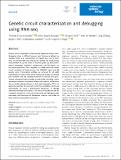Genetic circuit characterization and debugging using RNA‐seq
Author(s)
Gorochowski, Thomas Edward; Espah Borujeni, Amin; Park, YongJin; Nielsen, Alec Andrew; Der, Bryan S.; Gordon, David B; Voigt, Christopher A.; ... Show more Show less
Download952.full.pdf (2.228Mb)
PUBLISHER_CC
Publisher with Creative Commons License
Creative Commons Attribution
Terms of use
Metadata
Show full item recordAbstract
Genetic circuits implement computational operations within a cell. Debugging them is difficult because their function is defined by multiple states (e.g., combinations of inputs) that vary in time. Here, we develop RNA‐seq methods that enable the simultaneous measurement of: (i) the states of internal gates, (ii) part performance (promoters, insulators, terminators), and (iii) impact on host gene expression. This is applied to a three‐input one‐output circuit consisting of three sensors, five NOR/NOT gates, and 46 genetic parts. Transcription profiles are obtained for all eight combinations of inputs, from which biophysical models can extract part activities and the response functions of sensors and gates. Various unexpected failure modes are identified, including cryptic antisense promoters, terminator failure, and a sensor malfunction due to media‐induced changes in host gene expression. This can guide the selection of new parts to fix these problems, which we demonstrate by using a bidirectional terminator to disrupt observed antisense transcription. This work introduces RNA‐seq as a powerful method for circuit characterization and debugging that overcomes the limitations of fluorescent reporters and scales to large systems composed of many parts.
Date issued
2017-11Department
Massachusetts Institute of Technology. Department of Biological EngineeringJournal
Molecular Systems Biology
Publisher
Nature Publishing Group
Citation
Gorochowski, Thomas E, Amin Espah Borujeni, Yongjin Park, Alec AK Nielsen, Jing Zhang, Bryan S Der, D Benjamin Gordon, and Christopher A Voigt. “Genetic Circuit Characterization and Debugging Using RNA‐seq.” Molecular Systems Biology 13, no. 11 (November 2017): 952. © 2017 The Authors
Version: Final published version
ISSN
1744-4292